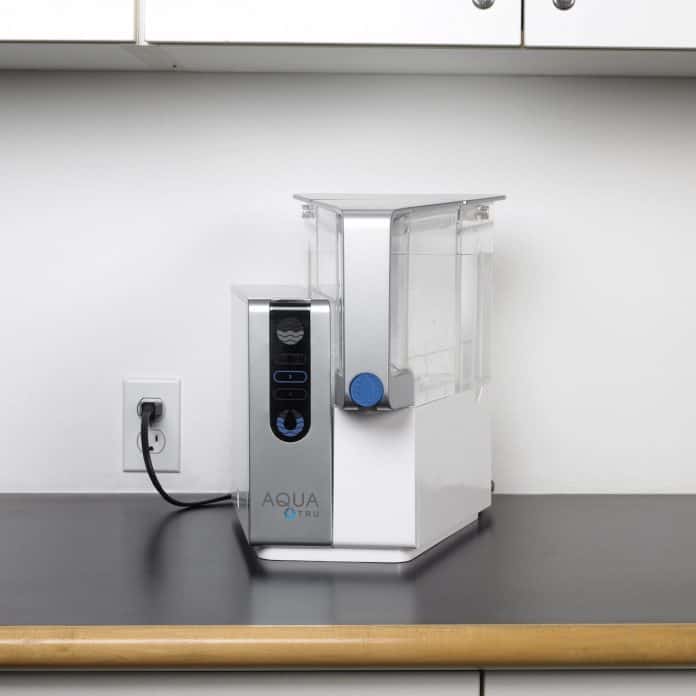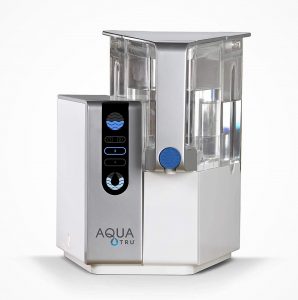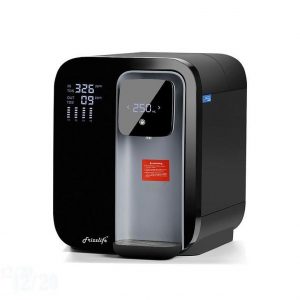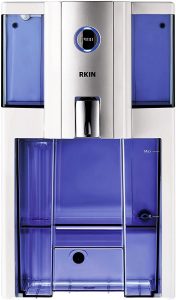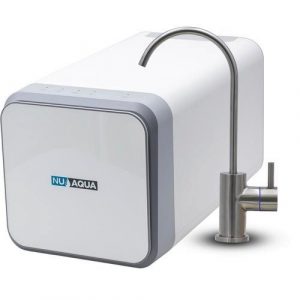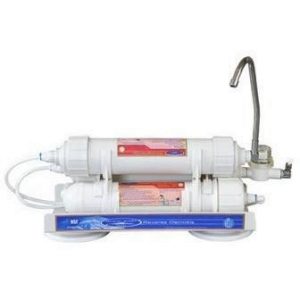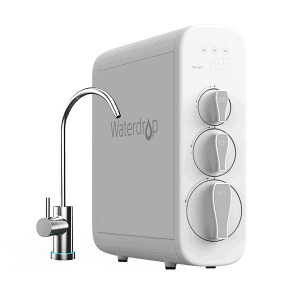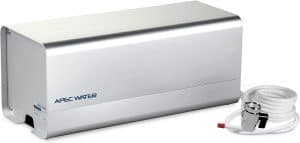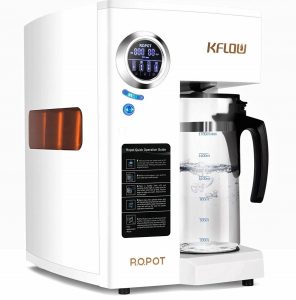Most of us drink water containing harmful pollutants such as chemicals, radionuclides, and arsenic. These pollutants, if left unchecked, can become extremely dangerous for you and your family.
You need a highly efficient and effective system to remove these contaminants. This is where the reverse osmosis system comes in.
Reverse osmosis systems are one of the most effective ways to provide clean water to your home. Unlike other water filtering methods, these systems are incredibly efficient, eliminating up to 99 percent of the pollutants in your water.
We understand that you might not have much experience with these filters, so we are here to help you. Our in-depth reviews about these filters will give you all the knowledge you need to decide on buying the ideal RO system for your home.
Our detailed guide will explain how this system works and what you should look for while buying a RO filtration system. This way, you can select the right system for your and your family’s home.
Table of Contents
Top 9 Best Countertop Reverse Osmosis Systems
1. Best Countertop Reverse Osmosis System: AquaTru RO System
If you are looking for the most efficient reverse osmosis system, the AquaTru RO System is the ideal option. Let us look at some of the system’s amazing features.
- With its four-stage filtration, the AquaTru can eliminate a wide range of pollutants from water, such as chlorine, lead, chromium-6, cysts, fluoride, certain medicines, and volatile organic compounds (VOCs). In addition, this system, which includes a pressure pump, is meant to work quickly, so you won’t have to wait long for filtered water.
- The AquaTru RO system does filtration in four steps. In steps 1 and 2, water passes through a coconut shell-activated carbon filter, which serves as a pre-filter, collecting big particles like rust and dust. It also eliminates compounds that affect the smell and taste of water, such as chlorine. In the 3rd step, the RO membrane removes fluoride and heavy metals. The last step involves a carbon block activated carbon filter, which filters any remaining foul flavor, chemical compounds, and pesticides.
- The AquaTru RO system has received NSF certification for standards p473, 42, 401, 58, and 53, which cover the removal of almost 82 harmful pollutants from your drinking water.
- This ensures that this RO system will give you and your family the safest, purest, and best-tasting water. Furthermore, the system removes thousands of more toxins in addition to the 82 approved. The system can create a gallon of cleaned water every ten to fifteen minutes, approximately 100 gallons daily.
- The AquaTru RO system is highly efficient and uses approximately 20% of water while producing around 80% clean water, wasting significantly less than other systems. In addition, you need not worry about the wastewater as it has its tank, which you’ll need to clear now and again.
Pros
- The AquaTru RO system is easy to set up and maintain.
- It has a compact design.
- It has a large water reservoir.
- It has a 4 step filtration process.
Cons
- It is a bit expensive compared to other filters.
Summary
The AquaTru RO system contains a four-step filtration system that removes approximately 82 pollutants, such as chlorine, lead, chromium-6, cysts, fluoride, certain medicines, and volatile organic compounds (VOCs), from your drinking water.
This RO filtration system will give you and your family the safest, purest, and best-tasting water.
Aquatru has a new model with a cleaner design and similar functions; the Countertop RO water purifier is called Aquatru Carafe; you can read the full review here.
2. Runner-Up: Frizzlife WA99 Reverse Osmosis Countertop Water Filtration System
The Frizzlife WA99 is yet another unique four-stage countertop water filtration system.
- This filter removes 99.99 percent of a wide range of pollutants from water. It eliminates common contaminants, including arsenic, chlorine, radium, fluoride, heavy metals, and lead.
- Frizzlife’s water filtration ratio is a significant advantage of this system. This filter produces 5 gallons of purified water for every gallon of wastewater, so it won’t add much to your weekly water cost.
- The Frizzlife has a built-in total dissolved solids (TDS) meter, which helps you know precisely how much TDS is in your entering and exiting the water. As a result, you can quickly compare the two TDS levels to ensure that your system operates properly.
- If the TDS in your incoming water is more than it should generally be, it’s time to replace your filters. It relieves you from the stress of remembering the date of the filter change. The system gives you the exact knowledge about the status of your filter cartridges, telling you exactly when it’s time to be replaced.
- The Frizzlife WA99 Reverse Osmosis Countertop Water Filtration System has a four-stage filtration system. In the first stage, it filters floating particles such as silt, dirt, and sand. The next stage uses a carbon filter which removes chemicals and chlorine from the water. The reverse osmosis membrane removes approximately 1000 contaminants from water in the third step, including chromium, lead, parasite, and arsenic. Finally, in the last stage, the granular activated carbon is used to eliminate left impurities and enhance the water taste.
Pros
- It has a compact design.
- It removes almost 1000 types of contaminants from water.
- Its GAC filters last up to 12 months.
- It shows the lifespan of filters present in it.
Cons
- Water tank is small.
Summary
This RO system has a four-stage filtration system that removes 99.99 percent of a wide range of pollutants from water.
It eliminates common contaminants, including arsenic, chlorine, radium, fluoride, heavy metals, and lead. It has a built-in total dissolved solids (TDS) meter, which helps you know exactly how much TDS is in your entering and exiting the water.
3. Waterdrop Countertop Reverse Osmosis Water Filter System
My readers get a 10% discount at WaterDropFilter.com – Use code INDOOR at checkout.
Check the new model here!
- The Waterdrop Countertop System is a RO filtration system that removes 90 percent TDS from your drinking water using a 0.0001-micron membrane.
- This RO system uses a stage filtration system to remove harmful contaminants from water. These two filters include a carbon block filter and a reverse osmosis membrane. The three filter stages work together to eliminate various pollutants from tap water, such as fluoride, rust, nitrates, chlorine, PFAS, sand, and lead. Moreover, it purifies UV, removes contaminants such as bacteria and viruses, and delivers clean, safe drinking water.
- After every three gallons of water, this RO filtration system wastes only 1 gallon. This makes it one of the most efficient systems present in the market.
- The Waterdrop Countertop System is straightforward to install. It requires no complicated setup. All you have to do is plug the unit in and turn it on, and it’s good to go.
- This RO system is also easy to maintain. It has a self-cleaning option, but you’ll also have to replace the filter and wash the water tank.
Pros
- It wastes a very minimal amount of water.
- It only needs two filter changes.
- Its carbon filter can last up to six months.
Cons
- Waterdrop Countertop System may leak if not cleaned properly.
4. RKIN Countertop Reverse Osmosis Water Filter
My readers get an 8% discount at PureWaterGuys.com – Use code Indoor at checkout.
RKIN Countertop RO water filtration system is one of the most efficient water filters with a four-stage filtration process.
- It removes 99% of contaminants from water, including chlorine, lead, heavy metals, fluoride, arsenic, and mercury.
- This RO water filter gives you two choices: buy it with an alkaline remineralized stage or without it. The alkaline remineralized stage removes all the minerals removed by reverse osmosis and impurities. These minerals include magnesium and calcium, essential for our day-to-day activities. While adding these minerals back into the water, it just not improves your health but also enhances the taste of water.
- On the other hand, if you don’t want these minerals back, you can get the other unit which doesn’t include any total dissolved solids, back into the water. So it is the best option for people looking for pure water without dissolved minerals.
- It has a 4-stage filtration system that starts with a sediment filter of five-micron and concludes with a post filter.
- The RKIN Countertop Reverse Osmosis water filter does not require much electricity, so you need not worry about the bill.
- It is pretty efficient in terms of water wastage.
Pros
- RKIN Countertop Reverse Osmosis water filter has a four-stage water filtration system.
- It does not affect the water flow.
- It does not waste much water.
Cons
- The tank capacity is small.
Summary
RKIN Countertop RO water filtration system is one of the most efficient water filters with a four-stage process. It removes 99% of contaminants from water, including chlorine, lead, heavy metals, fluoride, arsenic, and mercury. This RO water filter wastes only one gallon of water. It has a water ratio of 1:1.
5. NU Aqua Efficiency Series Tankless 600GPD Reverse Osmosis System 2:1 Pure To Waste
NU Aqua Systems has introduced the NU Aqua 600GPD Tankless reverse osmosis water filtration system (WU-600GPD-TL) to its already excellent inventory to follow the tankless trend.
- This RO water filter features an integrated pump. As a result, it is not hindered by a water tank, allowing it to handle up to 600GPD more quickly than a traditional under-sink reverse osmosis system.
- Compared to some RO systems that only have a ratio of 1:1, 1:2, or 1:3, this water filter gives a water wastage ratio of 2:1. This makes it one of the most effective and efficient under-sink RO alternatives if water conservation is essential to you!
- The RO faucet of the NU Aqua 600GPD Tankless reverse osmosis water filtration system has an LED ring that illuminates blue light to indicate that everything is working well and red to indicate one of your filters requires replacing. This red light immediately lets you know when you have to change the filters. Lights on the body indicate the total system health and the filter status.
- The NU Aqua 600GPD Tankless RO water filter is also one of the smallest reverse osmosis systems available, and it is simple to install.
Pros
- It is compact.
- The water waste ratio of this RO water filter is 2:1, which is quite efficient.
- Its red LED light indicates when the filter needs replacement.
Cons
- This water filter is expensive as compared to other filters.
Summary
It comes with an integrated pump which allows it to handle up to 600GPD more quickly than a traditional under-sink RO system.
In addition, the RO faucet of the NU Aqua 600GPD Tankless RO water filter has an LED ring that illuminates blue light to indicate that everything is working well and red to indicate that one of your filters requires replacing.
6. Crystal Quest Portable Reverse Osmosis System
Are you looking for the most efficient portable RO system for you and your family? Then, the crystal Quest Portable Reverse Osmosis System is the best option out there. You won’t get a more appropriate mobile RO system than the Crystal Quest if you’re looking for one. Like all countertop models, this unit does not require installation and includes several valuable features that make it more desirable than the others on this list.
- This RO system has multiple filtration stages, removing a range of water pollutants. It comes with a granular activated carbon filter which removes contaminants such as pesticides, Volatile organic compounds, and chlorine. The RO membrane removes any TDS present in water, chromium, lead, and arsenic in the next stage. Moreover, it prevents any bacteria from growing in your water. The next step removes any type of hard water minerals present in the water. Finally, the last stage has a GAC post-filter which removes any foul odor or taste in water, leaving fresh and clean water for you to drink.
- The Crystal Quest Portable Reverse Osmosis System provides 50 gallons of fresh water daily.
- The Crystal Quest does not require energy, so you can carry it with you almost everywhere as long as you have access to a regular faucet.
- This efficient system is cost-effective to operate and maintain, with annual costs ranging from $70-$90. It has a whopping ten stages of filtration and includes everything you need to get started right away.
- Since the Crystal Quest is small and compact, it can easily be transported without much room.
Pros
- It is compact and lightweight.
- It requires minimal maintenance.
- Installation of the Crystal Quest water filter is straightforward.
Cons
- The Crystal Quest is somewhat slower than another countertop reverse osmosis water filter system units as it produces roughly 2 gallons of filtered water each hour.
Summary
Like all countertop models, Crystal Quest Portable Reverse Osmosis System does not require installation and includes several valuable features that make it more desirable than the others on this list.
This RO system has multiple filtration stages, removing a range of water pollutants.
7. Tankless: Waterdrop G3 Reverse Osmosis Water Filter System
If you want to save some space in your kitchen, the Waterdrop G3 Reverse Osmosis Water Filter System is the ideal choice available for you out there.
- This RO water system comes with 7 stages of filtration, which eliminates almost 1000 types of pollutants from water. These pollutants include pathogens, chlorine, organic contaminants, sand, odor, and heavy metals.
- It includes three filters as a carbon block filter, reverse osmosis filter as a carbon filter.
- The Reverse Osmosis Water Filter System does not have a tank. This saves a lot of space in your kitchen.
- The Reverse Osmosis Water Filter System has undergone rigorous testing and is certified by ANSI and NSF standard 58. This makes it highly efficient and effective.
- It is incredibly efficient in creating clean drinking water compared to standard RO systems. It fills one glass of water in 12 seconds which is quite incredible. Similarly, despite its great purifying system, it produces 400 gallons of water each day.
- This RO Filteration System is simple to install because of its compact and stylish design. Similarly, the three significant filters may be swapped in under three seconds by twisting the knob. This RO water system has a wastewater ratio of 1:1, which proves its efficiency.
Pros
- It comes with a start and stops reminder.
- It is certified by NSF.
- This RO water filter is easy to install.
- It is simple to maintain
Cons
- This water Filter System cannot work for more than 30 minutes.
Summary
This filter has 7 stages of water filtration, which removes almost 1000 types of pollutants from water. These pollutants include pathogens, chlorine, organic pollutants, sand, odor, and heavy metals. It does not come with a tank, which saves you a lot of space.
8. APEC Water Systems RO-CTOP-C Portable Countertop Reverse Osmosis Water Filter System
There are only a few countertop RO systems that deliver what they promise. APEC water systems RO-CTOP-C Portable Countertop Reverse Osmosis Water Filter System is one of them. It is one of the ideal RO systems present on the market currently.
- As the top quality unit in APEC, this model offers super filtration capabilities. It can provide you with 90 gallons of water every day. Thus, it provides excellent drinking water nearly quickly without the use of a storage tank.
- The RO-CTOP-C Portable Countertop Reverse Osmosis Water Filter System is manufactured in the US. That is why you must not worry about its quality.
- In comparison to all of the recommended reverse osmosis systems, installation is substantially more straightforward. You must now connect the adapter to the tap, and the water filter will start producing pure water.
- Installing this RO system is relatively easy compared to many other RO systems. All you have to do now is connect the adapter to the tap, and the water filter will start producing pure water. Moreover, it does not require any drilling.
- This reverse osmosis system filters water in 4-stages. Its 4-stage system removes harmful contaminants from your water, leaving you with clean and pure water to drink. It eliminates 99% of TDS from your drinking water.
Pros
- It removes 99% of contaminants.
- It is made in the US.
- Its filters have a long lifespan.
- It is easy to install.
Cons
- The only con of this RO system is that it wastes 3 gallons of water on every gallon.
9. KFLOW (KFL-TDS-180) Reverse Osmosis Countertop Filter System
If you are in search of an efficient countertop RO system that does not waste water, the KFLOW (KFL-TDS-180) Reverse Osmosis Countertop Filter System is a smart option.
- By increasing the final recovery rate, this RO filtration system decreases the amount of water wasted.
- This RO system uses 4-stage filtration to eliminate 99% of impurities from water. It uses two filters: an activated carbon filter and a sediment filter.
- In the first stage, the sediment filter removes large contaminants from water. While on the other hand, the second stage uses the activated carbon filter, eliminating all the inorganic pollutants and their bad taste and smell. In the third stage of this system, an RO membrane is used to remove microbes, salts, and heavy metals from the water. In the last step, the carbon filter removes all the foul taste and odor present in the water.
- This RO filter requires no installation. All you have to do is plug the system, and you are good to go.
Pros
- It saves water.
- The filter replacement in this RO system is easy.
- It has a long lifespan.
Cons
- The KFLOW (KFL-TDS-180) Reverse Osmosis Countertop Filter System is a bit expensive.
Countertop Reverse Osmosis System Buying Guide
What is a Countertop Reverse Osmosis System?
Countertop RO systems are made by combining numerous reverse osmosis stages into a single small device that is stored on your kitchen counter. The reverse osmosis systems can filter up to 99% of TDS from the drinking water, giving it a cleaner, purer taste and fragrance.
Most of these systems are manufactured to be installed beneath the sink of your kitchen and are becoming more common among people. The countertop RO filter systems are great for homeowners who don’t want to struggle with cutting their waterline to install a RO filter.
If you live in a rented house, then these filters are the best option for you. The countertop reverses osmosis systems come with an RO semi-permeable membrane, making them unique compared to other filtration systems.
This membrane has tiny pores which do not let anything other than water molecules pass through it.
How Does A Countertop RO System Work?
The countertop reverse osmosis system works in the following steps:
- In the first step, the water inside it passes through a sediment pre-filter. This eliminates debris from the water, such as rust, dust, and sand, which is why this stage is critical.
- After that, a granular or activated carbon filter is used, which removes harmful contaminants such as chemicals, chlorine, unpleasant flavor, and smell from water through adsorption.
- After that, the water is frequently pumped through a reverse osmosis membrane, eliminating up to 99.9percent of the TDS from water.
- After that, a second carbon filter is usually used in many RO systems to remove any remaining particles. This is commonly referred to as a post-filter.
- Many RO water filtration systems also include an additional alkaline remineralization filter. This filter adds vital minerals back into the filtered water before it reaches the drinking faucet, giving your water a more pleasant alkaline taste.
Countertop RO System Advantages and Disadvantages
Advantages
- Reverse osmosis is one of the most advanced methods of filtering water. It’s so efficient that it removes all the impurities present in the tap water.
- The filtration speed of a countertop RO water filter is generally quite fast compared to other filtration systems.
- Installing a countertop RO water filter is simple; all you have to do is place it on your kitchen counter and plug it in. This will only take a few seconds of your time. You’ll unlikely make a mistake, so you don’t need to hire a plumber.
- It is ideal for renters as they don’t have to drill their sinks. They just have to place this on their countertop.
- These systems as very easy to maintain as compared to other water filtration systems.
- Since these systems are compact, they can be transported easily from one place to another. All you will need is enough water to fill them or a water supply.
- These filters do not require a water storage tank. You can get your water from the faucet directly.
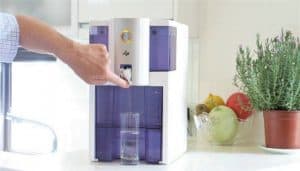
Disadvantages
- People who are used to drinking their water with minerals find it challenging to drink water through an RO countertop water filter system. It removes minerals from the water making your water taste bland.
- The most significant disadvantage of RO countertop water filtration systems is that they waste a lot of water while filtering it.
What to Consider Before Buying a Countertop RO Filter
There are certain things you must take care of before buying a countertop RO filter:
- Water Source
Water source is the most important thing you should consider to make your decision based upon it.
- Water Pressure & Wastewater
Since the RO water filtration systems do not have a built-in pressure pump, they depend solely on your home pipe’s water pressure to force water through the various filter stages. This has the advantage of requiring no additional power supply.
If your home’s water pressure is low, this could become a problem. The low water pressure causes both a slow flow rate and an increase in the volume of wastewater that goes down the drain.
- Flow Rate
The water pressure in your home impacts the flow rate: the faster your flow, the stronger the water pressure. So if your RO system connects to your faucet, you just need to be worried about the flow rate. If you want to get water quickly, that is why you will need a high flow rate.
- Remineralization Needs
If you drink mineral water, you must look for RO countertop water filtration systems containing alkaline remineralization filters. As many RO filters remove minerals from water, this additional filter will add these minerals back.
- Certificates
Before buying your RO system, always check the certifications this system has. The RO systems should have certifications according to NSF standards. These certifications ensure that this RO system efficiently removes specific contaminants from water.
- Filter Lifespan
Always check the lifespan of a filter before buying it so that you don’t have to replace it immediately after purchasing the RO system.
- Counter Space Available
Before choosing your RO system, make sure you have enough room. For example, if you have a small countertop, search for systems with a smaller footprint and don’t take up as much space in your kitchen.
The best way to ensure that is by measuring your available area and comparing it to the dimensions of the system you are planning on buying.
- Maintenance
There’s no need to be concerned because almost all countertop reverse osmosis water filters are low-maintenance. The expense of maintenance, on the other hand, is something you should consider.
Some RO systems are expensive but do not need additional maintenance costs. So always check the longevity, capacity, and cost of the replacement filters.
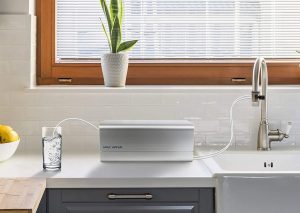
Countertop Reverse Osmosis Water Filter Maintenance
The countertop water filters are straightforward to maintain as compared to other water filtration systems. All you have to do is clean the outside of these filters with a cloth and replace the filters when needed.
However, maintenance is crucial as it will guarantee that your reverse osmosis filtration system works and looks at its best.
Frequently Asked Questions (FAQ)
Is reverse osmosis worth it?
If you want clean and pure drinking water without contaminants, reverse osmosis water filters are the best option.
Reverse osmosis water filters are the most efficient water filtration systems present in the market as they remove 99% of contaminants from water.
Do I need reverse osmosis if I have a whole house filter?
Reverse osmosis water filters are generally placed under the sink or on the top of your kitchen counter.
If you want to drink pure water with good taste and smell, you should go for reverse osmosis.
How much does a home reverse osmosis water filtration system cost?
On average, a home RO water filtration system can cost from $50 to almost $500. however, the cost depends upon the RO filtration system you buy; the more advanced it is, the more costly it is.
What is the most efficient reverse osmosis system?
Many reverse osmosis systems are available in the market, but the best out of them is AquaTru RO System with its four-stage filtration.
The AquaTru can eliminate a wide range of pollutants from water, such as chlorine, lead, chromium-6, cysts, fluoride, certain medicines, and volatile organic compounds (VOCs).
Is it healthy to drink reverse osmosis water?
Drinking from a RO filtration system will keep you healthy as it will remove all the harmful pollutants present in the water.
Do you need to add minerals to reverse osmosis water?
If you drink water with minerals, you should buy an RO system with additional alkaline remineralization filters.
What is better alkaline water or reverse osmosis?
Both alkaline water and reverse osmosis are good; it depends on the type of water you like drinking.
Does RO water taste like bottled water?
The water produced by RO water filters tastes completely bland.
Final words
After reading the detailed information we have provided about reverse osmosis systems, we believe that you will be able to make a sound decision and choose the system that best suits you and your family.

